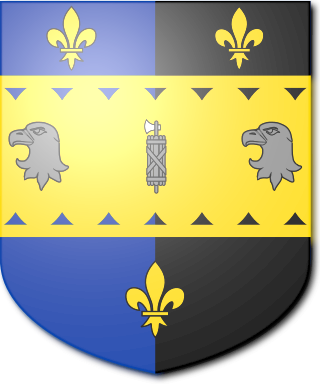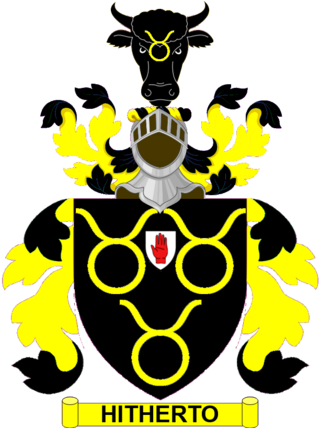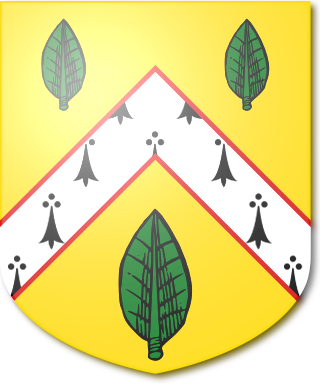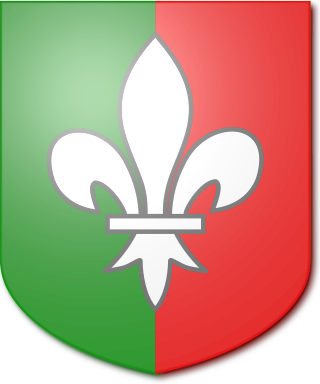
The Eliott Baronetcy, of Stobs in the County of Roxburgh, is a title in the Baronetage of Nova Scotia. It was created on 3 December 1666 for Gilbert Eliott. The second baronet was a member of the pre-union Parliament of Scotland. The third Baronet sat as Member of Parliament for Roxburghshire. The Eliott Baronets share a common early Elliot ancestry with the nearby Earls of Minto (Elliot). It is thought that the surname spelling differences were contrived to differentiate the branches.
There have been two baronetcies created for persons with the surname Aykroyd, both in the Baronetage of the United Kingdom for members of the same family.

The Whitehead Baronetcy, of Highfield House in Catford Bridge in the County of Kent, is a title in the Baronetage of the United Kingdom. It was created on 26 November 1889 for James Whitehead, Lord Mayor of London between 1888 and 1889 and later member of parliament for Leicester. His younger son, the third baronet, was also a Member of Parliament.

The Wigram Baronetcy, of Walthamstow House in the County of Essex, is a title in the Baronetage of the United Kingdom. It was created on 30 October 1805 for Robert Wigram, a successful shipbuilding merchant and politician, representing Fowey and Wexford Borough in the House of Commons. The second Baronet also represented Wexford Borough in Parliament. He assumed in 1832 by Royal licence the surname of Fitzwygram. The fourth Baronet was a Lieutenant-General in the army and sat as a Conservative Member of Parliament for South Hampshire and Fareham.

The Chance Baronetcy, of Grand Avenue in the parish of Hove in the County of Sussex, is a title in the Baronetage of the United Kingdom. It was created on 19 June 1900 for James Timmins Chance, a grandson of William Chance one of the Chance brothers who started the family business in 1771. He became head of Chance Brothers and Company. He was High Sheriff of Staffordshire in 1868.

The Bull Baronetcy, of Hammersmith in the County of London, is a title in the Baronetage of the United Kingdom. It was created on 25 November 1922 for the Conservative politician Sir William Bull. He represented Hammersmith and Hammersmith South in the House of Commons for many years. His eldest son, the second Baronet, died on active service in the Second World War and was succeeded by his younger brother, the third Baronet. As of 2019 the title is held by the latter's grandson, the fifth Baronet, who succeeded in 2019.

The Broadbent Baronetcy, of Longwood in the Parish of Huddersfield in the West Riding of the County of York, and of Brook Street, in the Parish of St George Hanover Square in the County of London, is a title in the Baronetage of the United Kingdom. It was created on 10 August 1893 for the noted physician William Broadbent. The title descended from father to son until the death of his grandson, the third Baronet, in 1987. The late Baronet was succeeded by his first cousin once removed, the fourth Baronet. He was the grandson of Walter Broadbent, third son of the first Baronet.
There have been four baronetcies created for persons with the surname Bell, all in the Baronetage of the United Kingdom. One creation is extant as of 2007.

The Couper Baronetcy is a title in the Baronetage of the United Kingdom. It was created on 23 June 1841 for George Couper. He was a colonel in the Army and fought in the Peninsular War, served as Military Secretary to the Governor Generals of Canada, Sir James Kempt and Lord Durham, and was Comptroller of the Household and Equerry to Her Royal Highness the Duchess of Kent. The second Baronet was an administrator in India and served as Governor of the North-West Provinces between 1877 and 1882. Another member of the family to gain distinction was James Kempt Couper, second son of the first Baronet. He was a general in the Army.

The Fletcher, later Boughey Baronetcy, of Newcastle-under-Lyme and of Betley both in the County of Stafford, is a title in the Baronetage of Great Britain. It was created on 24 August 1798 for Thomas Fletcher, of Betley Court, Staffordshire, High Sheriff of Staffordshire in 1783 and 1789 and Deputy Lieutenant of the county. He was the husband of Elizabeth Fenton, granddaughter of George Boughey, of Audley, Staffordshire whose will provided for his great-grandson to inherit the Audley estate.

The ffolkes Baronetcy, of Hillington in the County of Norfolk, is a title in the Baronetage of Great Britain. It was created on 26 May 1774 for Martin ffolkes, FRS later High Sheriff of Norfolk and Member of Parliament for King's Lynn. The second Baronet represented Norfolk and Norfolk West in the House of Commons while the third Baronet represented King's Lynn. The fifth Baronet was Honorary Chaplain to Queen Victoria, Chaplain-in-Ordinary to Edward VII and George V and Chaplain to Edward VIII and George VI.

The Elton Baronetcy, of Bristol, is a title in the Baronetage of Great Britain. It was created on 31 October 1717 for Abraham Elton, Mayor of and Member of Parliament for Bristol from 1722 to 1727. The second Baronet was also Mayor of Bristol and represented Taunton and Bristol (1727–1742) in the House of Commons. The seventh Baronet sat as Liberal Member of Parliament for Bath. The eighth Baronet was High Sheriff of Somerset in 1895. The tenth Baronet was a pioneer of the British documentary film industry.

The Buckworth, later Buckworth-Herne, later Buckworth-Herne-Soame Baronetcy, of Sheen in the County of Surrey, is a title in the Baronetage of England. It was created on 1 April 1697 for John Buckworth, High Sheriff of London in 1704. The second Baronet sat as Member of Parliament for Weobley. The third Baronet was Assistant Gentleman Usher to George II. The fifth Baronet was Gentleman-Pensioner and Exon of the Guard during the reign of George III. He married Anne, daughter of Paston Herne, of Haveringland Hall, Norfolk, and assumed by Royal licence the additional surname of Herne. The sixth Baronet assumed in 1806 by Royal licence the additional surname of Soame in compliance with the will of Sir Peter Soame, 4th Baronet, of Thurlow. The ninth Baronet was a member of the Shropshire County Council.
The Archdeacon of Malmesbury is a senior ecclesiastical officer within the English Diocese of Bristol. The archdeacon is responsibile for the disciplinary supervision of the clergy in its four rural deaneries: Chippenham, Kingswood and South Gloucestershire, North Wiltshire and Swindon. Christopher Bryan has been the archdeacon since 2019.

The Robinson Baronetcy, of Toronto in Canada, was created in the Baronetage of the United Kingdom on 21 September 1854 for the Canadian lawyer and politician John Robinson.
The Stewart Baronetcy, of Balgownie in Bearsden in the County of Dumbarton, was created in the Baronetage of the United Kingdom on 16 December 1920 for James Watson Stewart. He was a member of the Glasgow Corporation from 1904 to 1920 and Lord Provost of Glasgow from 1917 to 1920.

The Campbell baronetcy, of Aberuchil in the County of Perth, was created in the Baronetage of Nova Scotia in c. 1668 for Colin Campbell.

The Dunbar baronetcy, of Mochrum, Wigtownshire, was created for James Dunbar in the Baronetage of Nova Scotia on 29 March 1694. He married, firstly, Isabel Nicholson, daughter of the 2nd of the Nicolson Baronets of Carnock (1636), and through her came into the estate of Plean, Stirlingshire.

The Dunbar baronetcy, of Durn, was created for William Dunbar of Durne Fordyce, Banffshire, on 29 January 1698.

The Dunbar baronetcy of Hempriggs, Caithness, was created for Hon. James Dunbar, formerly James Sutherland, on 10 or 21 December 1706. He was a younger son of James Sutherland, 2nd Lord Duffus, and brother of the attainted Jacobite Kenneth Sutherland. He married Elizabeth Dunbar, daughter and heiress of Sir William Dunbar, 1st Baronet of the Dunbar baronets of Northfield (1700).
















